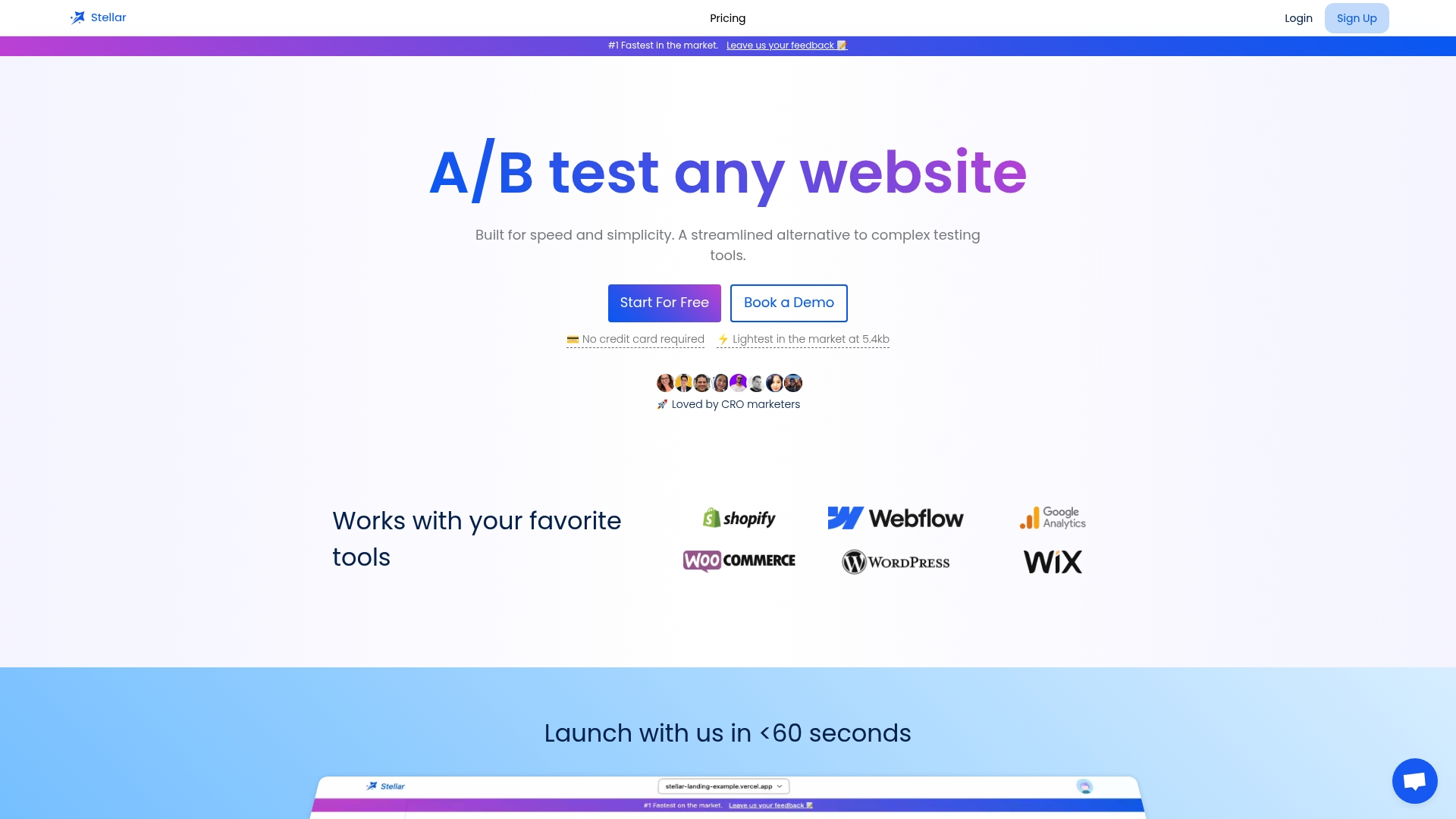
AB Testing for Product Pages: Boost Your Conversion Rates Now

Did you know that companies using structured A/B testing can achieve up to 50% higher conversion rates than those skipping this step? Clear goals and precise testing pave the way for real growth, separating random guesses from results that drive revenue. When you set sharp objectives and monitor the right metrics, each decision on your product page becomes smarter and more data driven. Discover how the right framework can turn simple tests into measurable wins.
Table of Contents
- Step 1: Define Clear Goals And Key Conversion Metrics
- Step 2: Segment Your Audience For Targeted Experiments
- Step 3: Design And Implement Test Variants Using Stellar
- Step 4: Launch Tests And Monitor Performance Metrics
- Step 5: Analyze Results And Deploy The Winning Version
Quick Summary
| Key Point | Explanation |
|---|---|
| 1. Define clear goals | Establish specific, measurable objectives to guide A/B testing efforts effectively. |
| 2. Segment your audience | Break down your audience into targeted groups for customized experiments that yield better insights. |
| 3. Test one major element | Focus on altering a single variable at a time to ensure clear results and accurate performance evaluation. |
| 4. Monitor performance metrics | Track key indicators like conversion rates and engagement levels to measure the success of tests accurately. |
| 5. Analyze and implement findings | After testing, analyze results critically and implement the variant that offers significant improvements. |
Step 1: Define clear goals and key conversion metrics
Successful A/B testing starts with crystal clear objectives. You need rock solid goals that transform vague intentions into measurable outcomes.
Defining meaningful conversion metrics means identifying exactly what success looks like for your specific product page. According to research from conversion rate optimization experts, key performance indicators typically include:
- Conversion rates
- Website traffic
- Revenue generation
- Customer lifetime value
- User engagement levels
- Cost of customer acquisition
- Product adoption rates
- Net Promoter Score (NPS)
Start by asking yourself critical questions: What specific behavior do you want visitors to take? Are you aiming to increase product purchases, email sign ups, or free trial registrations? Your goal must be precise and quantifiable.
For product pages, common conversion goals often center around:
Here's a summary of common key conversion metrics for product pages:
| Metric | What It Measures | Example Goal |
|---|---|---|
| Conversion Rate | Purchases or actions completed | 5% purchase rate |
| Average Order Value | Average spend per transaction | $120 per order |
| Cart Abandonment Rate | Shoppers leaving before buying | Reduce below 60% |
| Time on Product Page | User engagement on page | 2+ minutes average visit |
- Percentage of visitors completing a purchase
- Average order value
- Reduction in cart abandonment rates
- Increased time spent on product page
Pro Tip: Choose 2-3 primary metrics maximum. Too many goals create unfocused testing.
As research indicates, establishing clear objectives allows you to design targeted experiments that deliver meaningful insights. Without precise goals, your A/B tests become random shots in the dark.
Next, you will move into designing specific test variations that can potentially improve these key metrics. Get ready to transform your product page performance.
Step 2: Segment your audience for targeted experiments
Audience segmentation transforms generic A/B testing into precision marketing. You will learn how to slice your audience into meaningful groups that reveal deeper insights and drive smarter experiments.
According to advanced targeting research, utilizing multiple filters allows for incredibly precise audience targeting. Start by breaking down your audience using key characteristics such as:
- Demographics (age, gender, location)
- Behavioral patterns
- Device type
- Traffic source
- Previous purchase history
- Engagement levels
Research indicates that understanding your audience segments is critical for setting meaningful experimental objectives. As experts suggest, the goal is identifying which audience segments are most likely to impact your key conversion metrics.
Pro Tip: Focus on segments that represent at least 20% of your total traffic to ensure statistically significant results.
Consider creating 3 to 4 primary segments that capture meaningful differences in user behavior. For instance, a SaaS product might segment users into:
- New visitors exploring the platform
- Returning users considering upgrade
- Enterprise customers with complex needs
Each segment requires a tailored approach that speaks directly to their unique motivations and pain points.

With your audience segments defined, you are ready to design targeted experiments that speak directly to each group's specific needs and behaviors. Next, we will explore how to craft variations that resonate with these distinct audience segments.
Step 3: Design and implement test variants using Stellar
Creating effective A/B test variations requires strategic thinking and precise implementation. You will learn how to craft meaningful test variants that generate actionable insights for your product page.
When designing test variants, research on online experimentation suggests using adaptive algorithms that help optimize your creative display strategies. Start by identifying the key elements you want to test:
- Headline text and messaging
- Call to action button design
- Product image placement
- Pricing presentation
- Page layout and structure
- Testimonial positioning
With Stellar, you can leverage the visual editor to make rapid changes without complex coding. Focus on creating variations that are distinctly different yet still feel authentic to your brand.
Pro Tip: Limit yourself to testing one major element at a time to ensure clear attribution of performance changes.
According to experimental design studies, reducing algorithmic influence is crucial for reliable test results. This means controlling variables carefully and ensuring your test variants are truly comparable.
Consider these practical approaches for your Stellar A/B test:
- Create a control version (original page)
- Develop 1 2 alternative versions with specific changes
- Ensure consistent user experience across variants
- Set clear success metrics before launching
The goal is to generate statistically significant data that reveals genuine user preferences and behavior patterns.
With your test variants prepared, you are now ready to launch and monitor your experiment. Next, we will explore how to track and analyze the results effectively.
Step 4: Launch tests and monitor performance metrics
You are now ready to activate your A/B test and track its performance with surgical precision. This critical phase transforms your experimental setup into actionable insights that drive real business growth.
According to comprehensive research on A/B testing, successful monitoring requires tracking multiple key performance indicators:
- Conversion rates
- Website traffic
- Revenue generation
- Customer lifetime value
- User engagement levels
- Cost of customer acquisition
- Product adoption rates
- Net Promoter Score
Stellar provides real time analytics that make tracking these metrics seamless. Watch your dashboard closely and pay attention to statistical significance before drawing conclusions.
Pro Tip: Wait until you have at least 95% statistical confidence before making any definitive decisions about your test results.
As testing experts suggest, establishing clear objectives helps you interpret metrics more effectively. Focus on the specific conversion goals you established earlier.
Important monitoring strategies include:
- Setting up goal tracking
- Checking data consistency
- Comparing variant performance
- Identifying unexpected user behaviors
- Tracking segment specific results
Remember that A/B testing is an iterative process. The insights you gather today will inform your next round of optimization experiments. Your journey of continuous improvement starts now.
Step 5: Analyze results and deploy the winning version
The moment of truth has arrived. You will now transform your experimental data into meaningful improvements for your product page.
A/B test result reporting requires a systematic approach to interpreting your findings. According to comprehensive research on testing metrics, focus on these key performance indicators:
- Statistical significance
- Conversion rate differences
- Revenue impact
- User engagement changes
- Segment specific performance
Critical analysis steps include:
- Confirm 95% statistical confidence
- Compare variant performance holistically
- Analyze results across different user segments
- Validate unexpected behavioral patterns
- Understand the underlying user motivations
Pro Tip: Always consider the practical significance of results beyond pure statistical numbers.
When determining the winning variant, look beyond simple conversion rates. Evaluate the potential long term impact on customer experience and business goals.
After selecting your winning variation, implement it systematically. This means:
- Replacing the original page design
- Updating all relevant user touchpoints
- Documenting the changes and their rationale
- Preparing for continuous iteration
Remember that A/B testing is an ongoing journey of incremental improvements. Your first successful test is just the beginning of your optimization strategy.
Take Control of Your Product Page Performance with Stellar
Struggling to pinpoint which changes will truly boost your conversion rates is a common challenge highlighted in the article "AB Testing for Product Pages: Boost Your Conversion Rates Now." You may feel overwhelmed by unclear goals, scattered audience segments, and complex test designs. The key pain points of defining clear objectives, creating targeted experiments, and confidently analyzing results require a solution that simplifies every step.
With Stellar, you gain a powerful yet lightweight A/B testing platform built just for marketers and growth hackers who need fast and effective experimentation. Use our no-code Visual Editor to design impactful test variants effortlessly. Rely on advanced goal tracking and real-time analytics to monitor and segment your audience accurately. Our platform helps you reduce guesswork and deliver data-driven decisions with confidence.

Ready to stop shooting in the dark and start growing your product page conversions today? Discover how Stellar's user-friendly interface and smart testing capabilities transform insights into actionable improvements. Visit Stellar A/B Testing Tool now and unlock your product page's true potential.
Frequently Asked Questions
What are the primary goals I should aim for when conducting A/B testing on product pages?
To boost conversion rates effectively, identify clear objectives such as increasing purchase rates or reducing cart abandonment. Set specific metrics, like aiming for a 5% increase in conversions, to measure your success accurately.
How can I segment my audience for more effective A/B testing?
Segment your audience by key characteristics such as demographics, behavior, and previous purchase history. Aim to focus on segments that make up at least 20% of your traffic to ensure your results are statistically significant and actionable.
What elements should I test when designing A/B test variants for product pages?
Focus on key elements like headline text, call-to-action button design, and product image placement. Testing just one major element at a time can provide clearer insights, such as how changing the call-to-action affects conversion rates.
How do I know when to conclude my A/B test?
Conclude your test once you achieve a minimum of 95% statistical confidence in your results. Monitor your performance metrics and ensure you have enough data, typically within a few days to weeks, to reach a reliable conclusion about which variant performs better.
What should I do after analyzing my A/B test results?
After analyzing the results, implement the winning variant by replacing the original design and updating all relevant user touchpoints. Document your findings to inform future tests and enhance ongoing optimization efforts.
Can A/B testing reduce cart abandonment rates, and how can I measure this?
Yes, A/B testing can significantly reduce cart abandonment rates by optimizing the checkout process or improving product page layout. Set a clear goal to reduce abandonment rates by a specific percentage, like below 60%, and track this metric through your experiments.
Recommended
- Split Testing Product Pages: Boost Conversions in 2025
- Boost Shopify Conversions with A/B Testing: A Guide for Store Owners
- 10 A/B Testing Ideas That Will Skyrocket Your Landing Page Conversions
- Boost Your Ecommerce Conversion Rate: Proven Tactics for More Sales
- Optimizing Landing Pages: Proven Strategies for 2025
- Conversion Rate Steigern Anleitung: Schritt für Schritt zur Top-Performance - Onlinemarketing360
Published: 10/27/2025